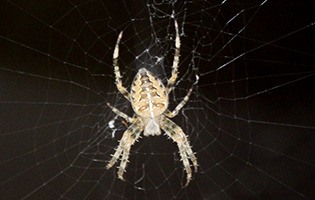New residents seem to be appearing on the island everyday. They are found on windowsills, porches, hanging off plants and in nooks and crannies.
“Spiderwebs are everywhere in my yard,” said Orcas resident Nicole Cline.
The species islanders are watching crop up are known as European cross spiders. Individual spiders’ coloring range from light yellow to dark gray, but all have mottled markings across the back with five or more white dots forming a cross. Rod Crawford, curator of arachnids at the Burke Museum in Seattle, told the Seattle Times in August that the presumed spider boom this year is a phrase he has heard every year for the last 30 years.
“There are always lots this time of the year,” echoed Orcas Islander Rochelle Severson.
Crawford accounts for the increasing visibility of these eight-legged creatures due to spiders coming into maturity and needing more space to make cobwebs. The spiders are hatched in early May and become adults in the late summer.
On his website, Crawford goes on to explain that August and September are actually the worst time of year for northern hemisphere spider collectors. Only a few spider species including the larger orb weavers and the giant house spiders are mature at that time, but not many other spiders are around.
Crawford is clearly prepared for a range of arachnid-oriented questions from the funny to the bizarre. His FAQ page is full of topics such as swallowing spiders while sleeping to camel spiders that run 25 miles per hour screaming like a banshee to a gigantic spider that lives in tunnels under Windsor Castle. These are all myths that Crawford dispels.
One popular myth is that spiders come indoors in the fall to escape the cold. According to Crawford, house spiders are not the same species as the yard or garden spiders, which live outdoors.
“If a large number appear [indoors] at a specific season, it is usually late summer and coincides with the mating season of the given species,” said Crawford.
Spiders are “cold-blooded” and not attracted to warmth.
“They don’t shiver or get uncomfortable when it’s cold, they just become less active and eventually, dormant,” said Crawford.
According to the staff of the WSU Plant and Insect Diagnostic Laboratory staff, spiders, due to their predacious nature, are beneficial; they
trap and eat flies and other insects. Spiders should be conserved not eradicated, they added.
Spiders in Washington state that have a venomous bite are black widows and hobos.
Black widow spiders are common in eastern Washington, and a few small populations exist on the western side of the state, according to the Washington Department of Health. Hobo spiders are found anywhere in Washington. Symptoms associated with spider bites can vary from minor to severe.
For Crawford many mystery bites are falsely attributed to spiders.
“Spiders have no reason to bite humans,” Crawford told the Seattle Times. “They are not bloodsuckers. They are not even aware of our existence.”
Only a few people have ever died from spider venom, he writes on his website.
For some islanders, watching the spiders arrive is a thrilling moment rather than a scary one. Orcas residents Victoria and Bathan Shaner sat down for dinner last week and noticed an arachnid show unfold outside.
“The spider would wait at the top of the web for the ants to land then would maneuver down to put the ant to sleep, spin it in the web, then move to the next one,” Victoria said. “It was incredible to watch what spiders can do and the web itself was beautiful.”
For more spider info, visit http://www.burkemuseum.org/spidermyth.



